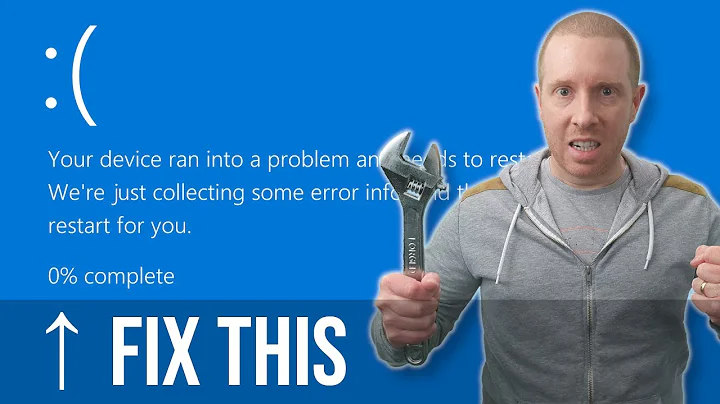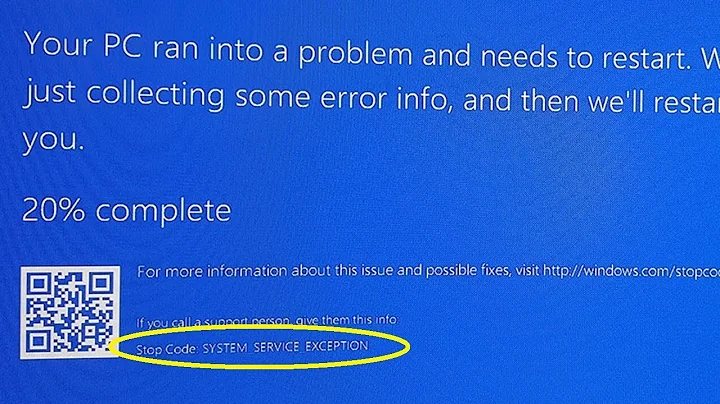How to find the source of this BSOD? How to fix it?
Solution 1
- Install the Debugging Tools for Windows.
- After Installing, open WinDbg from start menu.
- Click File > Symbol File path and enter
SRVC:\SymbolCachehttp://msdl.microsoft.com/download/symbols(replace C:\SymbolCache with path of your choice) - Click File > Open Crashdump and open the memory.dmp file in your %SystemRoot% (usually C:\WINDOWS or C:\WINNT) OR the latest file in %SystemRoot%\Minidump if you have full dumps disabled.
- The offending driver will be listed below, similar to this:
Probably caused by : usbhub.sys ( usbhub!UsbhTrapFatalTimeout_x9f+28 ), but you can click the!analyze -vlink to get detailed stack trace.
Solution 2
A much simpler way would be to use BlueScreenView. If you look into the "Address In Stack" column you can see where the problematic call originally came from. This is the last row that has an entry in this column.
Taking the driver file name you can back-track the vendor/application/device it belongs to and therefore find the culprit with a high probability.
Related videos on Youtube
Eternal Learner
Updated on September 18, 2022Comments
-
Eternal Learner almost 2 years
I occasionally (always at the least convenient moment...) receive this BSOD on my Windows 7 desktop PC:
Problem signature: Problem Event Name: BlueScreen OS Version: 6.1.7601.2.1.0.256.1 Locale ID: 1033 Additional information about the problem: BCCode: 124 BCP1: 0000000000000000 BCP2: FFFFFA8007BBB028 BCP3: 00000000B2000040 BCP4: 0000000000000800 OS Version: 6_1_7601 Service Pack: 1_0 Product: 256_1 Files that help describe the problem: C:\Windows\Minidump\010812-16578-01.dmp C:\Users\al\AppData\Local\Temp\WER-37500-0.sysdata.xmlTrying to find out more information about this seems to be futile because the file
C:\Users\al\AppData\Local\Temp\WER-37500-0.sysdata.xmldoesn't exist (the folder exists, but not any file that starts with "WER"), and attempting to analyze the minidump file yields the following:Bug Check Code: 0x00000124 Parameter 1: 00000000`00000000 Parameter 2: fffffa80`07bbb028 Parameter 3: 00000000`b2000040 Parameter 4: 00000000`00000800 Causing driver: hal.dll Address: hal.dll+12a3b Processor: x64 Crash address: ntoskrnl.exe+7cc40 CPU count: 4 Major ver: 15 Minor ver: 7601 Dump size: 283,576and:
Filename: ntoskrnl.exe Addr. in Stack: ntoskrnl.exe+18d513 From addr: fffff800`02a18000 To addr: fffff800`03001000 Size: 0x005e9000 Timestamp: 0x4e02aaa3 Time string: 6/22/2011 9:53:23 PM Product name: Microsoft® Windows® Operating System File desc: NT Kernel & System File ver: 6.1.7601.17640 (win7sp1_gdr.110622-1506) Company: Microsoft Corporation Full path: C:\Windows\system32\ntoskrnl.exeWell,
hal.dllandntoskrnl.exeare part of the OS and there doesn't seem to be anything I can do to upgrade those "drivers".I know that the hardware is perfect (including RAM voltages in BIOS etc) because this same exact system works perfectly with
Ubuntu 8andUbuntu 10(triple-boot config). The problem is definitely in the system software, but how do I find out what it is?-
 m0skit0 over 12 yearsWe could help you if Windows 7 was open source...
m0skit0 over 12 yearsWe could help you if Windows 7 was open source... -
user3660103 over 12 yearsDo any of the steps from [here](sevenforums.com/crash-lockup-debug-how/… help?
-
Eternal Learner over 12 years@AndrejaKo This is a great resource. Looks like exactly what I have been looking for. Please re-post as an answer and I will accept it. Thanks +1 for now.
-
 Moab over 12 years@Eternal Learner Simply linking to an answer is not considered an answer here at SuperUser, it should remain a comment unless they want to copy the entire content of the answer over to a SuperUser answer. The main reason for this is link rot and websites that disappear from cyberspace. Second reason is SuperUser is not a forum.
Moab over 12 years@Eternal Learner Simply linking to an answer is not considered an answer here at SuperUser, it should remain a comment unless they want to copy the entire content of the answer over to a SuperUser answer. The main reason for this is link rot and websites that disappear from cyberspace. Second reason is SuperUser is not a forum.
-
-
Eternal Learner over 12 yearsThis is good for driver developers, not for an admin.
-
Eternal Learner over 12 yearsBlueScreenView is exactly where I took the information I posted in my question. The back-track stops at what I posted originally:
ntoskrnl.exe+18d513. The comment posted by @AndrejaKo is the best answer so far. -
kinokijuf over 12 years@EternalLearner But it shows you the BSOD source, which is a good thing.
-
kinokijuf over 12 years@EternalLearner Then I’m afraid it’s impossible to get further info.




